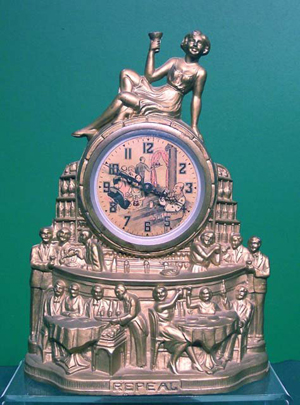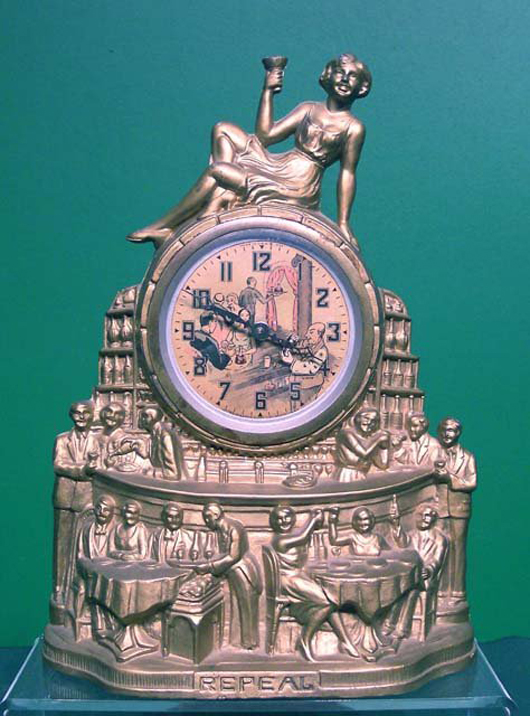
It’s not illegal to drink alcoholic beverages, but making booze or transporting it in bottles and barrels is a federal offense thanks to Sen. Andrew Volstead and the 18th Amendment.
Fast forward eight decades and 1,925 miles west to Kennewick and a well-kept home in Canyon Lakes.
Descend into Jerry Johnson’s inner sanctum, his Prohibition-era poolroom, and sneak a peek into the world of gangster Al Capone.
Here are mementos of ax-wielding Carrie Nation, who delighted in smashing up saloons, and “Revenuers,” also known as agents of the Federal Bureau of Alcohol, Tobacco and Firearms.
And there are FBI wanted posters for George “Machine Gun” Kelly, John Dillinger, “Baby-Face” Nelson and “Pretty-Boy” Floyd.
Johnson spent more than half a year creating the specially decorated poolroom, using artifacts representing the era from 1920 to 1933.
Among the items hanging on the walls are a replica Thompson submachine gun and shadow boxes with paraphernalia from the dry days when the only legal way to obtain alcohol was with a federal government prescription.
Johnson said he converted what had been a spare room in the basement about four years ago and added a pool table.
When guests started dubbing his poolroom Jerry’s Speakeasy, Johnson quietly started the remodeling project.
Using his cabinet-making skills, Johnson spent nearly nine months crafting and installing wainscoting, adding faux finish paint to the walls, installing lighting appropriate for the period and acquiring collectibles to display.
He also created what is the room’s most talked about feature – the point of entry.
This basement speakeasy not only has no windows, but it also lacks a door.
That’s not to say it has no entrance. It simply has no traditional point of entry.
First-time visitors heading to the poolroom go down the stairs as directed, then usually pause to look at Johnson’s model railroad layout before noticing a small workroom at the end of the short hall. A built-in bookcase is on the adjacent wall, but there appears to be no other place to go.
“I tell them to go into the pool room, and they ask, ‘Where is it?’” Johnson said.
He then gives a gentle push, and the floor-to-ceiling bookcase swings into the poolroom.
“It’s heavily over-engineered and has heavy-duty hinges and a caster to help distribute the weight,” said Johnson, who is director of information technology at Pacific Northwest National Laboratory in Richland.
Most people are fooled, he said.
The secret entrance makes a good impression, but his collectibles are equally impressive.
There are several photos of Al Capone showing the gangster socializing with his associates, and a large picture of agents dumping a barrel of whiskey into a New York sewer in the early 1920s, while the deputy police commissioner looks on approvingly.
Another photo of a parade in 1931 from Newark, N.J., has dozens of young men carrying signs that declare “We want beer.”
They got their wish two years later when the Volstead Act was repealed.
The speakeasy walls also have a framed front-page article from the Dec. 6, 1933, Chicago Herald Tribune declaring “20 Million Gallons in Canada Ready for Delivery.”
One of the speakeasy’s most unusual items is a genuine prescription for liquor, written on a federal Treasury Department order form.
There are postcards and pins, protest items and memorabilia from the “Drys” calling for continuation of Prohibition.
“I made so many trips to Michael’s (craft store), I had a personal framer,” Johnson said.
An antique wet bar, with a selection of liquor bottles line up in front of the ornately framed mirror, and a working desk telephone from the 1930s, complete the decor.
A descendant of Swedish immigrants, Johnson said he chose to focus on Chicago and Prohibition because his parents grew up in Chicago during the Depression.
“This is my way of getting back to my family’s roots,” he said.
Just for fun, visitors who are allowed to enter Jerry’s Speakeasy have a special surprise to take home.
Johnson had special double-shot glasses made with the image of a gangster holding a shotgun, and a message: “I’ve been shot at Jerry’s Speakeasy.”
___
Information from: Tri-City Herald, www.tri-cityherald.com
Copyright 2011 Associated Press. All rights reserved. This material may not be published, broadcast, rewritten, or redistributed.
AP-WF-05-31-11 1720GMT
ADDITIONAL IMAGE OF NOTE


